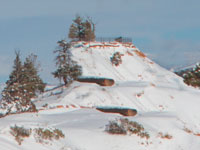ultrachrome inkjet print
139 x 39 inches
2012 – 2013
Piracy is a meditation on digital landscape photography’s resonance with public ownership of shareable resources, performances of individual identity through prosumer practices, and symbolic devices that condition ethical experiences of images and cultural products.
The image was formed by combining multiple photographs made near Piracy Point at Bryce Canyon National Park in Utah. In order to create a seamless panorama, one small section featuring a distant informational waypoint sign was subtly manipulated. This alteration destabilizes the indexical value of the photograph, calling into question its authority to represent truth or reinforce conceptions of nature as an entity divorced from human constructions. It places critical pressure on the mediating text – namely, this artist statement, and/or the waypoint sign that provides an interpretive framework for experiencing the landscape image.

This somewhat mundane picture of a celebrated viewshed also points to contemporary imaging practices, particularly the proliferation of tourist picture making, as serial or repetitious performances of the human body participating in space, matter, power, and time. It both affirms and questions the experience of an individual photographer who produces aestheticized landscape pictures nearly identical to those that can be readily located online, in history, or in other archives. Specific photographs are not as significant as the contemporary centrality of making and sharing photographs to the formation or representation of individual identity. Since images constitute a major portion of the cultural and linguistic currency exchanged in media-saturated communities, they serve well as metonym for issues of copyright and intellectual property with regard to other digital objects that may be copied in various infinite ways.
In this light, any immediate visual content of a cultural product may be seen to cede its primacy to accompanying power dynamics which center upon use and access. Does the harvesting of photographs from public lands such as national parks detract from the value of those places? How does this question relate to digital file sharing? What has been taken, or is being taken, and from whom? Here we return again to notions of piracy.

